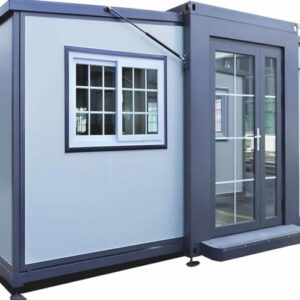Container Homes: Redefining Sustainable Living Spaces
Introduction:
Container homes, a revolutionary approach to sustainable housing, have gained immense popularity in recent years. In this comprehensive guide, we delve into the world of container homes, exploring their design possibilities, environmental benefits, cost-effectiveness, and the growing movement toward eco-friendly living.
1. *The Genesis of Container Homes:*
Container homes originated from the innovative repurposing of shipping containers into habitable dwellings. These steel structures, once used for transporting goods across the globe, now serve as the building blocks for eco-conscious and cost-effective living spaces.
2. *Design Flexibility and Creativity:*
a. *Modular Construction:*
Container homes embrace a modular construction approach, allowing for endless design possibilities. Containers can be stacked, arranged, and combined to create unique and customizable living spaces that cater to individual preferences.
b. *Architectural Innovation:*
Architects and designers have embraced the challenge of transforming industrial containers into modern, stylish homes. From minimalist designs to elaborate multi-container structures, the adaptability of container homes allows for a broad spectrum of architectural innovation.
c. *Interior Comfort:*
Container homes can be outfitted with all the comforts of traditional houses. Smart space utilization, innovative storage solutions, and contemporary interior designs contribute to creating comfortable and aesthetically pleasing living environments.
3. *Environmental Benefits of Container Homes:*
a. *Upcycling and Recycling:*
Repurposing shipping containers for homes reduces the environmental impact associated with their disposal. Upcycling these containers not only conserves resources but also minimizes waste, aligning with sustainable building practices.
b. *Energy Efficiency:*
Container homes can be designed with energy efficiency in mind. Incorporating insulation, energy-efficient windows, and renewable energy sources can significantly reduce the ecological footprint of these dwellings, making them environmentally responsible living options.
c. *Reduced Carbon Footprint:*
The construction of container homes typically requires fewer raw materials compared to traditional houses. This results in a lower carbon footprint, making container homes a sustainable choice for environmentally conscious individuals.
4. *Cost-Effectiveness and Affordability:*
a. *Lower Construction Costs:*
Building with shipping containers often translates to lower construction costs. The modular nature of containers streamlines the building process, reducing labor and material expenses compared to traditional construction methods.
b. *Quick Construction Time:*
Container homes can be assembled more rapidly than traditional homes. The off-site fabrication of container modules and their subsequent on-site assembly contribute to quicker construction timelines, further enhancing cost-effectiveness.
c. *Long-Term Savings:*
Container homes are known for their durability and low maintenance requirements. Over time, homeowners can benefit from long-term savings on maintenance and utility costs, making container living not only affordable in the short term but also financially sustainable in the long run.
5. *Challenges and Considerations:*
a. *Insulation and Temperature Control:*
Proper insulation is crucial for container homes to provide comfortable living spaces. Addressing temperature control challenges associated with steel structures ensures year-round comfort for residents.
b. *Building Regulations:*
Container homes may be subject to specific building codes and regulations, varying by location. Before embarking on a container home project, it’s essential to understand and comply with local building standards.
c. *Customization and Space Limitations:*
While container homes offer flexibility in design, some may find the limited width and height of standard containers constraining. Creative design solutions and thoughtful planning can overcome these challenges.
6. *The Future of Container Homes:*
As the global interest in sustainable living continues to rise, container homes represent a glimpse into the future of eco-friendly housing. With ongoing advancements in design, construction techniques, and sustainable technologies, container homes are poised to play a pivotal role in shaping the next generation of residential architecture.
7. *Conclusion:*
Container homes stand at the intersection of innovation, sustainability, and affordability. From their humble origins as cargo carriers to their transformation into stylish and eco-conscious dwellings, container homes have captured the imagination of those seeking a harmonious blend of modern living and environmental responsibility. As the movement toward sustainable housing gains momentum, container homes are likely to remain at the forefront of this transformative wave, offering a viable and exciting alternative for the conscientious homeowner.









